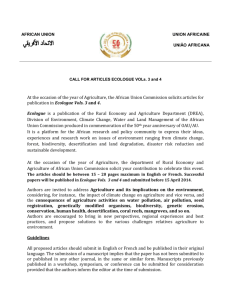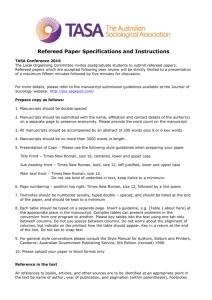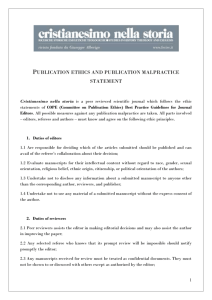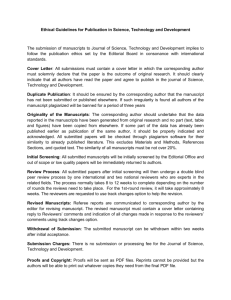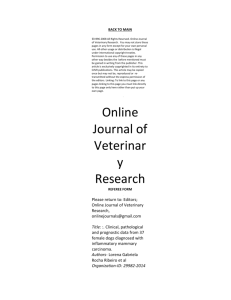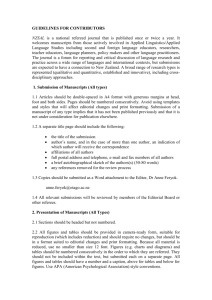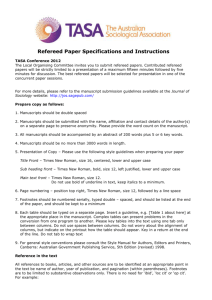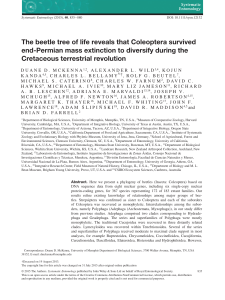Instructions for authors - Koleopterologische Rundschau
advertisement
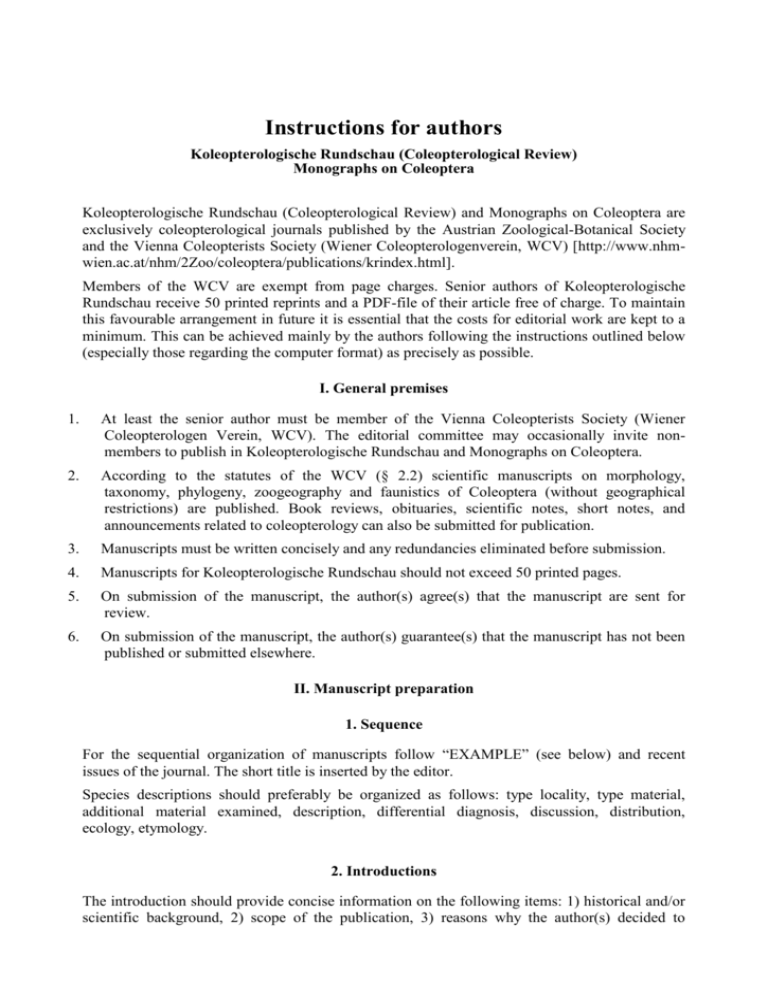
Instructions for authors
Koleopterologische Rundschau (Coleopterological Review)
Monographs on Coleoptera
Koleopterologische Rundschau (Coleopterological Review) and Monographs on Coleoptera are
exclusively coleopterological journals published by the Austrian Zoological-Botanical Society
and the Vienna Coleopterists Society (Wiener Coleopterologenverein, WCV) [http://www.nhmwien.ac.at/nhm/2Zoo/coleoptera/publications/krindex.html].
Members of the WCV are exempt from page charges. Senior authors of Koleopterologische
Rundschau receive 50 printed reprints and a PDF-file of their article free of charge. To maintain
this favourable arrangement in future it is essential that the costs for editorial work are kept to a
minimum. This can be achieved mainly by the authors following the instructions outlined below
(especially those regarding the computer format) as precisely as possible.
I. General premises
1.
At least the senior author must be member of the Vienna Coleopterists Society (Wiener
Coleopterologen Verein, WCV). The editorial committee may occasionally invite nonmembers to publish in Koleopterologische Rundschau and Monographs on Coleoptera.
2.
According to the statutes of the WCV (§ 2.2) scientific manuscripts on morphology,
taxonomy, phylogeny, zoogeography and faunistics of Coleoptera (without geographical
restrictions) are published. Book reviews, obituaries, scientific notes, short notes, and
announcements related to coleopterology can also be submitted for publication.
3.
Manuscripts must be written concisely and any redundancies eliminated before submission.
4.
Manuscripts for Koleopterologische Rundschau should not exceed 50 printed pages.
5.
On submission of the manuscript, the author(s) agree(s) that the manuscript are sent for
review.
6.
On submission of the manuscript, the author(s) guarantee(s) that the manuscript has not been
published or submitted elsewhere.
II. Manuscript preparation
1. Sequence
For the sequential organization of manuscripts follow “EXAMPLE” (see below) and recent
issues of the journal. The short title is inserted by the editor.
Species descriptions should preferably be organized as follows: type locality, type material,
additional material examined, description, differential diagnosis, discussion, distribution,
ecology, etymology.
2. Introductions
The introduction should provide concise information on the following items: 1) historical and/or
scientific background, 2) scope of the publication, 3) reasons why the author(s) decided to
publish the article. An introduction should serve to lead the reader into the subject of the paper. It
must not contain results or lengthy discussions and it must not be extensively narrative.
3. Authors of taxa
1. Authors of taxa (e.g., Hydraena riparia KUGELANN) must not be abbreviated. As an exception,
Linnaeus (L.) and Fabricius (F.) may be abbreviated.
2. Authors of taxa should be used only when mentioned for the first time in the text, in the
headings and in the abstract.
4. Spaces
Do not leave two spaces after periods and colons in the running text.
Examples for correctly set spaces: 100 m; 0.2 mm (= 200 µm); 2 km W Grammatneusiedl; leg. Schödl;
leg. W.D. Shepard; 5 + 4 ; 5.III.1988; KODADA (1974c, 1980d, 1981); (Abb. 8, 9c–f, 11–13);
10 exs.; 0.20–0.45 mm long; 2.3x as long as wide; O. (s.str.) lebetinus; syn.n.; sp.n.
5. Citations
1. Citations in the running text:
The form of citations in the running text differentiates unmistakably between a citation of a taxon
and a citation of a publication.
a) ... according to SCIAKY (1997) the distribution of this species is unknown ... [citation of a publication]
b) ... the distribution of this species is unknown (SCIAKY 1997)... [citation of a publication (no comma
between author and year of publication)]
c) ... the distribution of Stomis extorris SCIAKY, 1997 is unknown... [citation of the species (comma between
author and year of publication)]
d) ... nothing is known about the distribution of Stomis extorris (SCIAKY, 1997)... [citation of the species
(comma between author and year of publication); this species was originally described in another genus]
2. Citations in the references section:
Names of journals must not be abbreviated for the following reasons: 1) there is a very large (and
still increasing) number of scientific journals with similar names; 2) there is no significant gain
in space if journal names are abbreviated in the references section; 3) although there are several
world lists of abbreviations of journal names, these lists may differ from one another and their
abbreviations may deviate from a journal’s own preferred abbreviation; 4) since computers are
generally in use it does not save time to compile abbreviated references.
Unfortunately, in a handful of journals the “true” publication date frequently deviates from the
publication date given in the journal volume or on reprints as it reflects the year in which the
issue should have appeared. In such cases the incorrect publication date should be given in
brackets after the volume number (see below, under FERY 1992 and RIBERA & FOSTER 1993).
It should be noted that journals may have changed their names during their history:
1925–1954:
1955–1971:
1972–present:
Bulletin & Annales de la Société entomologique de Belgique
Bulletin & Annales de la Société Royale d’Entomologie de Belgique
Bulletin & Annales de la Société royale belge d’Entomologie
1947–1970:
1971–present:
The Coleopterists’ Bulletin
The Coleopterists Bulletin
BERCIO, H. & FOLWACZNY, B. 1979: Verzeichnis der Käfer Preußens. – Fulda: Parzeller & Co, 369 pp.
BURAKOVSKY, B., MROCZKOVSKI, M. & STEFAŃSKA, J. 1976: Chrząszcze Coleoptera Adephaga prócz
Carabidae, Myxophaga, Polyphaga: Hydrophiloidea. – Katalog Fauny Polski XXIII: 1–307.
FERY, H. 1992: Revision der “minutissimus-Gruppe” der Gattung Bidessus Sharp (Coleoptera:
Dytiscidae). – Entomologica Basiliensia 14 (1991): 57–91.
HEBAUER, F. 1989: Familienreihe Hydrophiloidea (Palpicornia). – In Lohse, G.A. & Lucht, W. (eds.):
Die Käfer Mitteleuropas, Vol. 3. – Krefeld: Goecke & Evers, pp. 72–92.
HORION, A. 1949: Faunistik der mitteleuropäischen Käfer I. – Frankfurt/Main: Vittorio Klostermann,
388 pp.
JÄCH, M.A. & JI, L. 1995: Introduction, pp. 5–32. – In Jäch, M.A. & Ji, L. (eds.): Water Beetles of
China, Vol. I. – Wien: Zoologisch-Botanische Gesellschaft in Österreich and Wiener
Coleopterologenverein, 410 pp.
JÄCH, M.A. & SHARMA, S. 1998: Nepalese water beetles (Coleoptera) Dryopidae, Elmidae,
Helophoridae, Hydraenidae, Heteroceridae, and Hydroscaphidae. – Proceedings of the
International Conference on Ecohydrology of High Mountain Areas, Kathmandu, Nepal, 24–28
March 1996: 599–607.
JANSSENS, E. 1968a: Hydraenidae d’Armenie. – Bulletin & Annales de la Société Royale d’Entomologie
de Belgique 104: 109–117.
JANSSENS, E. 1968b: 139. Hydraenidae: Ochthebius Leach, II Ergebnisse der zoologischen Forschungen
von Dr.Z.Kaszab in der Mongolei. – Reichenbachia 11 (9): 83–86.
KADDOURI, A. 1986: Révision des Hydraena du Maroc, d’Algérie et de Tunesie (Coleoptera,
Hydraenidae). – University of Toulouse (unpublished thesis), 156 pp.
KNISCH, A. 1924: Hydrophilidae. – In Schenkling, S. (ed.): Coleopterorum Catalogus, Part 79. – Berlin:
W. Junk, 306 pp.
RIBERA, I. & FOSTER, G.N. 1993: Uso de Coleópteros acuáticos como indicadores biológicos
(Coleoptera). – Elytron VI (1992): 61–75.
SATÔ, M. 1985: Hydraenidae. – In Uéno, S.-I., Kurosawa, Y. & Satô, M. (eds.): The Coleoptera of Japan
in Colour, Vol. II. – Osaka: Hoikusha Publishing, pp. 203–204.
SHATROVSKIY, A. 1989: 11. Hydraenidae (Limnebiidae). – In Ler, P.A. (ed.): Opredelitel nazekomych
dalnevo vostoka SSSR, Vol. III, Part 1. – Leningrad [St. Petersburg]: Academy of Sciences, pp.
260–264.
6. Label data
When describing new species or subspecies, or when referring to type specimens (holotypes,
paratypes, paralectotypes, lectotypes, syntypes, neotypes) it is strongly recommended that the
label data are copied as accurately as possible. To demonstrate that these data are reproduced
precisely, they should be given between quotation marks. Different labels should be clearly
separated. To avoid misunderstandings, typographical errors should be followed by a “[sic]” or
by juxtaposing the correct name between square brackets. Historical geographical names should
be followed by their modern equivalents in square brackets as well. If explanations or
translations are useful they should also be added in square brackets.
Holotype of Philaccolus giganteus (NMW): “NEU HOLLAND [= Australia] 1885 \ Holotypus
Philaccolus giganteus sp.n. des. M. Balke 1998”
Lectotype of Hydraena pensylvanica KIESENWETTER (DEI): “Hydraena N.Y. .... [illigible word, ca.
4 letters, underlined]” [handwritten, with pencil], “Coll. Kraatz”, “Kiesenwetter det. Originaletikette
siehe Katalog I. p.215 [original label according to catalog of historical collections of the DEI, vol. I, p.
215]”, “DEI Eberswalde”, “det. Kniz [= Knisch] Ksw. [= Kiesenwetter] pennsylvanica [sic]”,
“HOLOTYPUS Hydraena pensylvanica KSW. det. M. Jäch 1992”
7. Abbreviations
A sentence should not begin with an abbreviation.
The following abbreviations should be used:
fam.n., subfam.n., trib.n., gen.n., subgen.n., sp.n., ssp.n., syn.n., nom.n., comb.n., stat.n., s.str., s.l., etc.
Fig. (plural: Figs.)
W, E, N, S, etc. [directions]
leg. [collected by], coll. [collection], det. [determined by], t. [Latin: teste (= attested or confirmed by)]
ex. [specimen] (plural: exs.), (German: Ex.)
Acronyms for private collections and museums should be presented in the following format; the
acronyms themselves are not necessarily binding:
ANIC
Australian National Insect Collection, Canberra
CASB
Chinese Academy of Sciences, Zoological Institute, Beijing
DEI
Deutsches Entomologisches Institut, Müncheberg [formerly: Eberswalde]
HUB Museum der Alexander Humboldt Universität, Berlin
ISNB
Institut National des Sciences Naturelles, Bruxelles
MCM
Museo Civico di Storia Naturale, Milano
MHNL
Muséum d’Histoire naturelle, Lyon [formerly: Musée Guimet d’Histoire naturelle, Lyon (MGL)]
MHNP
Muséum national d’Histoire naturelle, Paris
MNS
Staatliches Museum für Naturkunde, Stuttgart
MTD
Museum für Tierkunde, Dresden
NHML
The Natural History Museum, London [formerly: British Museum (Natural History)]
NMP
Národni Museum v Praze
NMW
Naturhistorisches Museum Wien
OLL
Oberösterreichisches Landesmuseum, Linz
TMB
Természettudományi Múzeum, Budapest
ZMH
Eläinmuseo (Zoologiska museet), Helsinki
ZMM
Zoological Museum, Moscow
ZSM
Zoologische Staatssammlung, München
8. Language
English and German are accepted as languages for publication. English manuscripts submitted by
authors to whom English is not their mother tongue must be linguistically revised by a native
English speaking entomologist who must be thanked in the acknowledgements or in the
introduction.
10. Geographical names
In taxonomic revisions, geography plays a very important role (e.g. in the compilation of
distribution data). None the less, experience has proved that authors often do not pay enough
attention to geographical data. Names of cities, mountains, etc., and borders of countries and
provinces are frequently subject to radical changes [e.g. Elisabethpol (until 1920) → Kirovabad
(until 1990) → Gyandzha or Gäncä (today)]. Geographical data found on labels or in the
literature very often do not represent modern names and can thus be subject to confusion or
deficiency. Thus it is the duty of any revising author to deal with geographical names as
accurately as possible. Historical geographical names must be traced back and their modern
equivalents added in square brackets.
Lectotype of Ochthebius hungaricus GANGLBAUER (NMW): “Herkulesbad [= today: Băile Herculane, SW
Rumania] ’01 [= 1901] \ leg.Winkler”.
According to GANGLBAUER (1895) this species occurs in “Kulab-Ost-Buchara, Turkestan” [= Kulyab,
Tadjikistan].
Type locality (according to BLABENSTEINER 1920): “Batavia” [= Jakarta], Java, Indonesia.
As for historical localities Merriam-Webster’s geographical dictionary or one of the numerous
internet sources can be recommended. As for historical localities in China and Central Asia see:
ZHAO, E. & ADLER, K. 1993: Herpetology of China. – New York: Society for the Study of
Amphibians and Reptiles, 522 pp.
SCHÜTZE, H. & KLEINFELD, F. 1995: Die Carabenformen Chinas mit dem ausführlichen
Verzeichnis ihrer Fundorte. – Schwanfelder Coleopterologische Mitteilungen, special issue III:
127 pp.
SCHÜZTE, H. & KLEINFELD, F. 1997: Carabusformen Sibiriens und Zentral-Asiens. – Gleichen,
Fürth: Schütze & Kleinfeld, 198 pp.
The use of modern geographical names should be as consistent and up-to-date as possible,
preferably following a single source (e.g., latest edition of the Times Atlas of the World, Encarta,
or Merriam-Webster’s geographical dictionary).
When listing distributional data, geographical names must be sequenced logically (e.g.,
geographically, alphabetically).
Distribution: Japan, China, Burma, Malaysia, Indonesia (Sumatra, Bali, Flores).
When listing several localities within one country these localities should be sorted according to
provinces (or equivalent political divisions).
T U R K E Y: KOCAELI (IZMIT): S Karamürsel, 4.VIII.1988, 10°12''W 58°34''S, leg. Kirschenhofer (NMW);
BALIKESIR: Aliova river, W Dursunbey, 2.VIII.1988, leg. Schmid (NMW); IZMIR: 40 km N Bergama,
4.VIII.1988, leg. Schönmann (NMW); ANKARA: Karaboğas river, ...
11. Ink drawings, halftones (photographs, slides, pencil drawings, water colour paintings)
Figures should be submitted as files (preferrably sent as e-mail attachments), either already
arranged in plates (CorelDRAW or Photo Shop) or as individual bitmaps (*.tif, *.jpg, *.bmp).
When plates are arranged in Photo Shop (*.psd) layers must not be flattened [German: Ebenen
nicht zusammenführen!].
If figures are submitted as individual files they should meet the following prerequisites: line
drawings (1-bit b/w), b/w halftones (8-bit greyscale), colour images (24-bit RGB). Files should
have enough resolution to enable a proper print output size at 300 dpi. If figures are submitted
individually a tentative pre-arrangement to plates (printed sketch or CorelDRAW-file or Photo
Shop-file) is appreciated.
Ink drawings and halftones that are not submitted as computer files and should be arranged in
plates which allow for reduction to page size (19.5 x 13.0 cm). Reductions should preferably
range between 40 % and 80 %. Halftones and ink drawings should not be mixed on the same
plate.
If colour plates are requested, authors are asked to pay 50 % of the production costs (app. 150
Euros).
Figures are numbered consecutively in Arabic numerals (character style: Arial, Univers, or any
similar font). For correct size of figure numbers on the plates see CorelDRAW-file.
Detailed morphological illustrations must be provided with a scale.
12. Computer format
Manuscripts must be submitted as computer file (preferrably sent through e-mail) in WORD.
Authors are requested to format paragraphs themselves using format styles of the “EXAMPLE”
below. Format styles, page setup (paper size, A4: 210 x 297 mm, and margins) can see WORDfile or text sample below.
The character style Times New Roman is used for the text (except in and for which
Bookshelf Symbol 3 is used, see below), Arial (or an similar type font, e.g. Univers) is used for
figure numbers (see above).
SMALL CAPS must exclusively be used for authors of taxa and authors of references. Small caps
must never be used for authors mentioned in the publication title of a reference, for collectors, for
determinators, or in the acknowledgements, etc.
JANSSENS, E. 1968: 139. Hydraenidae: Ochthebius Leach, II Ergebnisse der zoologischen
Forschungen von Dr. Z. Kaszab in der Mongolei. – Reichenbachia 11 (9): 83–86.
Scientific names of the genus group, species group and infrasubspecific names must be italicised.
Type size is 18 pt for headings H1 and H2, 12 pt for H3, H7 and P1, 11 pt for P5, P6 and P7, and
10 pt for format styles H4, H5, H6, P2, P3 and P4 (see “EXAMPLE”).
In keys, the empty space after the first ordinal number, and the serial dots must be indicated by
one tabulator, not by empty spaces and not by typing numerous dots (see “EXAMPLE”).
If figures are not incorporated in the text, figure captions must be inserted at the end of the file,
below the author’s address.
Special characters: Bookshelf Symbol 3 (available from the editor on request) must be used
instead of Times New Roman for male and female characters: , . Females must be lowered
by 3 pts: → .
In any case of doubt, male and female characters or quotation marks should be copied from here
(, ), or any other easily replacable character or character combination, e.g. § or mmm for male,
and $ or fff for female should be used.
Quotation marks, apostrophes, and minutes/seconds: “smart quotes” (in German: typographische
Anführungszeichen) and ‘smart apostrophes’ must be used instead of "straight quotes" (in
German: gerade Anführungszeichen) and 'straight apostrophes'. However, in order to distinguish
them between apostrophes (’), minutes (') resp. seconds ('') (used to describe geographical
coordinates) must be given as straight fonts.
13. Deadline
Experience has shown that a general deadline for submission of manuscripts is not practical.
However, it is recommended that manuscripts are sent in November or December since there is
then a good chance for them to be published in the forthcoming issue (in June).
14. Correspondence
Manuscripts should be sent to the editor: manfred.jaech@nhm-wien.ac.at
LAST UPDATE: January 13, 2005
EXAMPLE
Description of new species of Hydraenida GERMAIN
(Coleoptera: Hydraenidae)
M.A. JÄCH
Abstract
Two new species of Hydraenida GERMAIN (Coleoptera: Hydraenidae) are described from Chile: H.
franzi and H. sanctijacobi.
Key words: Coleoptera, Hydraenidae, Hydraenida, taxonomy, new species, Chile.
Introduction
The genus Hydraenida was described by GERMAIN (1901). Two species ...
Hydraenida franzi sp.n.
Hydraenida sp., FRANZ 1978: 25.
TYPE LOCALITY: Embalse de Jeso, Santiago de Chile, Chile.
TYPE MATERIAL: Holotype (NMW): “Anden b.Santiago Chile,lg.Franz \ Embalse de Jeso, Anden [upper side]
Sa 200 [under side]”.
ADDITIONAL MATERIAL EXAMINED:
C H I L E: CHILOE: La Zorra, 5 km N Latigo, 200 m a.s.l., springs, 10°12''W 58°34''S, 5.IX.1997, leg. J.A. Díaz, 5
, 2 (NMW); AISEN: ...
DIAGNOSIS: 2.15 mm long, 0.95 mm wide. Dark brown ...
Key to the species of Hydraenida
1[tab] Aedeagus long and slender[tab] ........................................................................................................ 2
Acknowledgements
I am grateful to ...
Reference
GERMAIN, P. 1901: Apuntes entomolojicos. Tres especies de Heloforidos Chilenos. – Anales de …
Dr. Manfred A. JÄCH
Naturhistorisches Museum, Burgring 7, A-1010 Wien, Austria (manfred.jaech@nhm-wien.ac.at)
Figs. 1 - 2: Aedeagus, lateral view, 1) Hydraenida franzi sp.n., 2) H. sanctijacobi sp.n.
